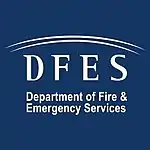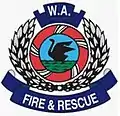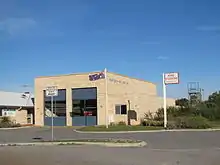Department of Fire and Emergency Services
The Department of Fire and Emergency Services (DFES) is a government department that is responsible for fire and emergency services in Western Australia. The department came into being in 2012 as a result of the Perth Hills Bush Fire review.[1]
DFES is responsible for the management, training and funding of career and volunteer Services including:
- The Bush Fire Service (BFS)
- Volunteer Fire and Rescue Service (VFRS)
- Career Fire and Rescue Service (CFRS or FRS)
- Volunteer Fire and Emergency Service (VFES)
- State Emergency Service (SES)
- Volunteer Marine Rescue Service (VMRS)
 Government agency logo | |
 WA Fire and Rescue (urban areas) | |
 WA Bush Fire Service (rural areas) | |
| Agency overview | |
|---|---|
| Formed | 2012 |
| Preceding agency |
|
| Jurisdiction | Government of Western Australia |
| Minister responsible |
|
| Agency executive |
|
| Child agencies |
|
| Website | www.dfes.wa.gov.au |

History
It was formerly known as the Fire and Emergency Services Authority of Western Australia (FESA), a statutory government authority created in January 1999 to administer the following legislation within the state of Western Australia:[3]
- Fire and Emergency Services Authority of Western Australia Act 1998
- Fire Brigades Act 1942
- Bush Fires Act 1954
- Emergency Services Levy Act 2002
- Emergency Management Act 2005
In the July 2017 Western Australian machinery of government changes, the department remained unaffected.[4]
Fire and Rescue Service of Western Australia
The inaugural meeting of the Fire Brigades' Board was held on 16 January 1899. This later led to the establishment of the Western Australian Fire Brigades' Board in 1909. WA Fire Brigades updated their name in 1995 to the Fire and Rescue Service of Western Australia, to more accurately reflect the service provided to the communities of Western Australia.[5]
In 1999, with the creation of FESA, brought together the Fire and Rescue Service, and the Bush Fire Service to form the Fire Services Division of FESA. The Fire and Rescue Service and Bush Fire Service actively maintain their original identities.
The Department of Fire and Emergency Services was established in 2012 and replaced FESA. The first Fire and Emergency Commissioner Wayne Gregson was appointed. Wayne Gregson is a former WA Police Assistant Commissioner. A new state of the art headquarters is located at Stockton Bend, Cockburn Central. This building includes the state and metropolitan operations centres, statewide communications centre, operations/capability commands and corporate services.
Structure
DFES operates under the Emergency Services Minister of the Government of WA and is the Hazard Management Agency (HMA) for cyclones, floods, storms, tsunami, structural collapse, HAZMAT incidents, earthquakes and fire. Their operational branch comprises Metropolitan Operations, Country Operations and Operations Capability and oversees the following services:
The Career Fire and Rescue Service of Western Australia (FRS or CFRS) consists of 1,190 paid firefighters working from 25 metropolitan stations and 4 country stations.[6]
The Volunteer Fire and Rescue Service (VFRS) is a volunteer service predominantly attending motor vehicle accidents, structure fires and HAZMAT incidents outside of metropolitan areas. In 2019 the VFRS had 2,371 volunteer firefighters in 94 brigades across the state.[7][8]
The Bush Fire Service (BFS) is a volunteer service tasked with attending any fire outside of a gazetted fire district within a brigade's local government area. They predominantly combat bushfires and conduct hazard reduction burning on a local level. As of 2019, there are 566 Bush Fire Brigades (BFBs) with 19,521 volunteers.[9]
The Volunteer Fire and Emergency Services (VFES) is also a volunteer service. It was established to combine the resources of any combination of a BFS Brigade, a VFRS Brigade, VMRS Group or an SES Unit to replace the Volunteer Fire Services (VFS) and Volunteer Emergency Service (VES) in 2016[10] It has just over 1,000 volunteers as of 2019.
The State Emergency Service (SES) is a volunteer service with the role of attending a vast array of natural disasters and search and rescue incidents. They attend land searches for missing people, storm damage, urban search and rescue (USAR), cliff rescue, transport personnel and equipment to fires as well as many other roles. The SES has a K9 unit with volunteer's dogs being trained in searching for missing people and a mounted unit for land searches. As of 2019 they had 1,839 volunteers.
The Volunteer Marine Rescue Service (VMRS) is another volunteer service tasked with assisting the Western Australian Police with searches for missing people or vessels, assisting disabled vessels and rescues in water around the state. As of 2019 there are 39 VMRS Groups with 1,752 volunteers.[11]
In April 2018 a new Rural Fire Division was announced after the findings of the 2016 Waroona Bushfire Special Inquiry. It will be another branch under the DFES structure and will consist of:[12]
- Bushfire Centre of Excellence (training and research into Bushfire mitigation)[13]
- Bushfire Risk Management Planning
- Bushfire Technical Services
- Land Use Planning
- Office of Bushfire Risk Management
Stations
Metropolitan Career fire stations

|
|
|
Country Career fire stations
Vehicles and equipmentThe Department maintains and coordinates a range of specialist equipment and emergency response vehicles. This includes pumpers and tankers, aerial ladders and other equipment designed to combat incidents including search and rescue, urban search and rescue (USAR), firefighting and other natural disasters. Appliances used by DFES brigades groups and units include:[14] BFS/VFES/VFRS/CFRS vehicles
SES/VFES Vehicles
Aerial Suppression and Fire MappingDFES utilises a range of water bombing and surveillance aircraft on loan from various companies and in collaboration with The Department of Biodiversity, Conservation and Attractions (DBCA) Parks and Wildlife Service. During the 2019/2020 Fire season, these include:[15]
Vehicles are named based on their water capacity, drive type (2x4/4x4) and role. For example: 1.4R meaning approximately 1000L, 4x4 and designed for a rural environment. PublicationsDFES publishes 24seven, a magazine.[17] See also
References
|









